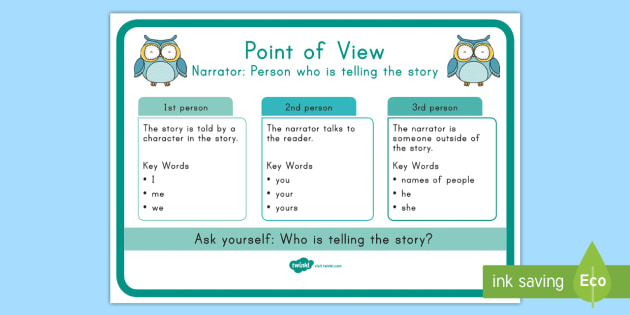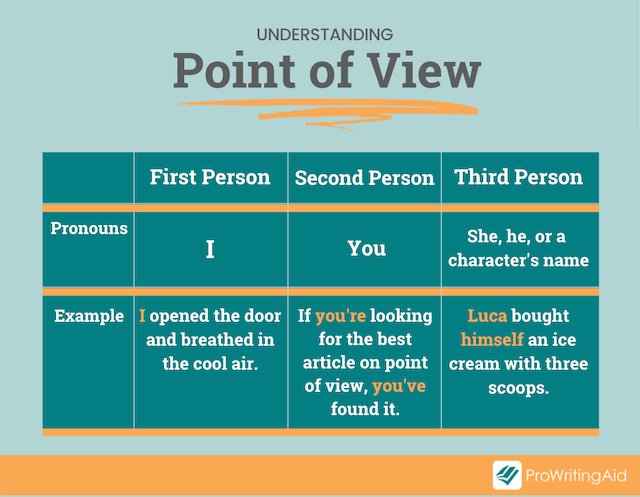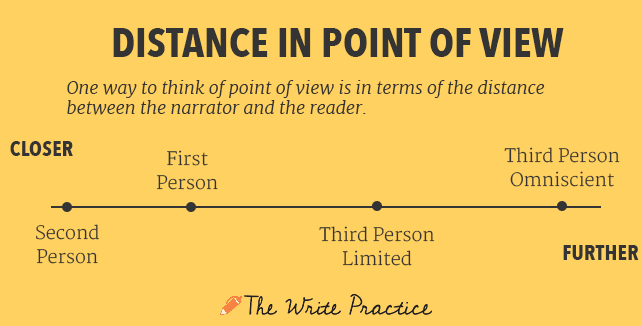
Narrative point of view is the perspective from which a story is told. It can be first person, second person, or third person. The choice of point of view is an important one, as it can affect the reader’s understanding of the story, the characters, and the author’s message.
### First Person Point of View
In first person point of view, the story is told from the perspective of one of the characters in the story. The narrator uses pronouns such as "I," "me," and "my" to refer to themselves.
First person point of view can be very effective for creating a sense of intimacy and immediacy with the reader. It allows the reader to experience the story through the eyes of the narrator, and to understand their thoughts, feelings, and motivations.
However, first person point of view is also limited by the narrator’s perspective. The reader can only know what the narrator knows, and they can only see what the narrator sees. This can be a problem if the narrator is unreliable, or if they do not have a complete understanding of the events of the story.
Some examples of stories told in first person point of view include:
- The Catcher in the Rye by J.D. Salinger
- To Kill a Mockingbird by Harper Lee
- The Hunger Games by Suzanne Collins
### Second Person Point of View
Second person point of view is rarely used in narrative fiction, but it can be effective for creating a sense of immersion for the reader. In second person point of view, the narrator addresses the reader directly, using pronouns such as "you" and "your."
Second person point of view can be used to create a sense of urgency and excitement in the reader, or to put them in the shoes of the main character. However, it can also be difficult to use effectively, and it can be jarring for the reader if they are not expecting it.
Some examples of stories told in second person point of view include:
- Choose Your Own Adventure books
- You Are a Wizard by Harry Potter
- House of Leaves by Mark Z. Danielewski
### Third Person Point of View
Third person point of view is the most common type of point of view used in narrative fiction. In third person point of view, the narrator is an outside observer who is not involved in the story. The narrator uses pronouns such as "he," "she," "it," and "they" to refer to the characters.
Third person point of view can be divided into two subcategories:
- Third person limited: In third person limited point of view, the narrator is limited to the thoughts and feelings of a single character. This allows the reader to get to know that character very well, but it also means that the reader is limited in their understanding of the other characters and the overall story.
- Third person omniscient: In third person omniscient point of view, the narrator is all-knowing. They have access to the thoughts and feelings of all the characters, and they can see and know everything that happens in the story.
Third person omniscient point of view can be used to tell a story from multiple perspectives, and to provide the reader with a complete understanding of all the characters and events. However, it can also be difficult to use effectively, as it can be difficult for the narrator to maintain a neutral point of view.
Some examples of stories told in third person limited point of view include:
- Harry Potter series by J.K. Rowling
- The Lord of the Rings series by J.R.R. Tolkien
- The Handmaid’s Tale by Margaret Atwood
Some examples of stories told in third person omniscient point of view include:
- Great Expectations by Charles Dickens
- Pride and Prejudice by Jane Austen
- To the Lighthouse by Virginia Woolf
## Choosing the Right Point of View
The choice of point of view is an important one that should be made carefully. The author should consider the type of story they are telling, the characters they want to develop, and the message they want to convey.
There is no right or wrong answer when it comes to choosing a point of view. The best point of view for a story is the one that will allow the author to tell their story most effectively.
## Tips for Writing in Different Points of View
Here are a few tips for writing in different points of view:
- First person: When writing in first person, be sure to use the pronoun "I" consistently. The reader should always know whose perspective they are seeing the story from.
- Second person: When writing in second person, be careful not to overuse the pronoun "you." It can be jarring for the reader to be constantly addressed directly.
- Third person limited: When writing in third person limited, be sure to limit the narrator’s knowledge to
WebIn defining a point of view the writer, speaker or director of the text controls what we see and how we relate to the situation, characters or ideas in the text. Point of view may be. WebHere are the basic narrative points of view: Omniscient (all seeing): This narrative perspective gets into any characters’ thoughts. Readers are given details that no one. WebAbstract. Point of view in narrative is a focal angle of seeing, hearing, smelling, and sensing the story’s settings, characters, and events. Researchers within the fields of. WebDefinition of Point of View. Point of view is utilized as a literary device to indicate the angle or perspective from which a story is told. Essentially, point of view refers to the “eyes” of the. WebIn first person point of view the narrator is a character in the story telling it from their perspective. In third person point of view the narrator is not part of the story and the.

Narrative Point of View | Twinkl Teaching Wiki – Twinkl – Source: twinkl.co.uk

Second-Person Point of View: Guide and Examples – Source: prowritingaid.com

Point of View in 2023: From First Person to Third Person Limited and Omniscient – Source: thewritepractice.com
What Is The Point Of View Of A Narrative Text, First person vs. Second person vs. Third person – Rebekah Bergman, 7.32 MB, 05:20, 935,799, TED-Ed, 2020-06-25T15:00:57.000000Z, 2, Narrative Point of View | Twinkl Teaching Wiki – Twinkl, 315 x 630, jpg, , 3, what-is-the-point-of-view-of-a-narrative-text
What Is The Point Of View Of A Narrative Text. WebWhat Is Narrative Point of View? (View all literary devices) Authors don’t speak to us directly in literary works. They use an intermediary device called a narrator. Narrative point of.
Discover how point of view can transform a story, and find out how to choose between first, second, and third person in your writing.
—
Who is telling a story, and from what perspective, are some of the most important choices an author makes. Told from a different point of view, a story can transform completely. Third person, first person, and second person perspectives each have unique possibilities and constraints. So how do you choose a point of view for your story? Rebekah Bergman explores the different ways to focus a story.
Lesson by Rebekah Bergman, directed by Gibbons Studio.
Animator’s website: gibbonsstudio.net/
Sign up for our newsletter: bit.ly/TEDEdNewsletter
Support us on Patreon: bit.ly/TEDEdPatreon
Follow us on Facebook: bit.ly/TEDEdFacebook
Find us on Twitter: bit.ly/TEDEdTwitter
Peep us on Instagram: bit.ly/TEDEdInstagram
View full lesson: ed.ted.com/lessons/first-person-vs-second-person-vs-third-person-rebekah-bergman
Thank you so much to our patrons for your support! Without you this video would not be possible! Hugo Legorreta, Zhexi Shan, Gustavo Mendoza, Bárbara Nazaré, Josh Engel, Natalia Rico, Andrea Feliz, Eysteinn Guðnason, Bernardo Paulo, Victor E Karhel, Sydney Evans, Latora Slydell, Oyuntsengel Tseyen-Oidov, Noel Situ, Elliot Poulin, emily lam, Juan , Jordan Tang, Kent Logan, Alexandra Panzer, Laura Cameron Keith, Jen , Ellen Spertus, Cailin Ramsey, Markus Goldhacker, Leora Allen, Andras Radnothy, Chris, Arpita Singh, Vijayalakshmi, Marc Bilodeau, Peng, Tzu-Hsiang, paul g mohney, Maya Toll, Sebastian Regez, Bruno Hannud, Andreas Voltios, Shubham Arora, Ugur Doga Sezgin, Akinola Emmanuel, Kyanta Yap, Ricardo Rendon Cepeda, Ana Maria, Benjamin & Shannon Pinder, Ernest Chow, Bela Namyslik, Alan Froese, Anika Westburg, Nick Cozby, Shawar Khan, Michael Braun-Boghos, Rohan Gupta, Elizabeth Cruz, Yujing Jiang, Sarah Lundegaard, Vladimir Ivanchenko, Georg Gusewski, Rohit Lodha, Erica Zhuang, Aaron Henson, Julio Sabatés Rodríguez, Vivian & Gilbert Lee, Fahad Nasser Chowdhury, ரமணன், John simmons, June Reiling, Khalid AlAli, Mickey Mikeworth, Nathaniel Lupus and Yansong Li.
Narrative Point of View | Twinkl Teaching Wiki – Twinkl
What Is The Point Of View Of A Narrative Text, WebAbstract. Point of view in narrative is a focal angle of seeing, hearing, smelling, and sensing the story’s settings, characters, and events. Researchers within the fields of. WebDefinition of Point of View. Point of view is utilized as a literary device to indicate the angle or perspective from which a story is told. Essentially, point of view refers to the “eyes” of the. WebIn first person point of view the narrator is a character in the story telling it from their perspective. In third person point of view the narrator is not part of the story and the.
First person vs. Second person vs. Third person – Rebekah Bergman

Source: Youtube.com
How to analyze narrative perspective – point of view – narration

Source: Youtube.com
What is the point of view of a narrative essay.
What is the point of view of a narrative essay
What is the point of view of a narrative essay What is the meaning of narrative point of view.
What is the meaning of narrative point of view
What is the meaning of narrative point of view What is the point of view in a narrative.
.
What is the point of view in a narrative
What is the point of view in a narrative What is the narrative point of view of the story.
.
What is the narrative point of view of the story
What is the narrative point of view of the story What is the point of view in a narrative.
blog.reedsy.com › guide › point-of-viewPoint of View: The Ultimate Guide to Writing Perspectives
Point of view (POV) is the narrative perspective from which a story is told. It’s the angle from which readers experience the plot, observe the characters’ behavior, and learn about their world. In fiction, there are four types of point of view: first person, second person, third person limited, and third person omniscient. .
www.grammarly.com › blog › point-of-viewWhat Is Point of View in Writing, and How Does It Work?
Point of view in writing is the position from which a story is told. A simple way to think about point of view is to ask: Where is the narrator? Give your writing extra polish Grammarly helps you communicate confidently Write with Grammarly What is point of view? Point of view is the writer’s way of deciding who is telling the story to whom. .
.
.
.
.
.
.
.
literarydevices.net › point-of-viewPoint of View – Examples and Definition of Point of View
Essentially, point of view refers to the “eyes” of the narrative voice that determine the position or angle of vision from which the story is being relayed. .
www.k12reader.com › term › narrative-point-of-viewWhat is Narrative Point of View? | Definition and Examples
Narrative point of view is the perspective of that narrator. First person narrative point of view occurs when the narrator is telling the story. “Call me Ismael,” the first line of Melville’s novel, Moby Dick, reveals that the story will be in first person point of view. .
www.litcharts.com › point-of-viewPoint of View – Definition and Examples | LitCharts
The three primary points of view are first person, in which the narrator tells a story from their own perspective (“I went to the store”); second person , in which the narrator tells a story about you, the reader or viewer (“You went to the store”); and third person , in which the narrator tells a story about other people (“He went to the store”). .